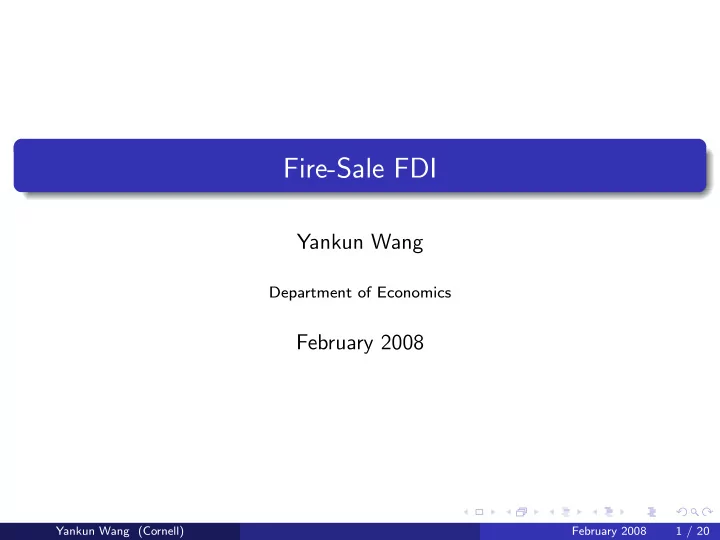

Fire-Sale FDI Yankun Wang Department of Economics February 2008 Yankun Wang (Cornell) February 2008 1 / 20
What is Fire-Sale FDI? During a liquidity crisis, there is an increase in foreign acquisition of domestic �rms and a decline in the price of acquisitions during the crisis. A few examples ( Paul Krugman, 1998): P&G puchased a majority share of Ssanyojng Paper Co, a producer of sanitary napkins, diapers, and kitchen towels. Hanwha Group's oil re�ning company sold its half of a joint venture in chemicals to the German company BASF. Korean Air Lines, with a �eet of more than 100 jets, had a market capitalization at the end of 1997 of $240 million, roughly the price of two Boeing 747s. "Mochael Jackson is getting into the action, negotiating to qcquire a ski resort from its owner, a bankrupt Korean underwear maker..........." Aguiar and Gopinath (2005) used a �rm-level data set to show that foreign acquisitions increased by 91% in East Asia between 1996 and 1998. Yankun Wang (Cornell) February 2008 2 / 20
More Evidence: Yankun Wang (Cornell) February 2008 3 / 20
More Evidence: Yankun Wang (Cornell) February 2008 4 / 20
More Evidence: Yankun Wang (Cornell) February 2008 5 / 20
Krugman's Model I: Moral Hazard and Asset De�ation Implicit Guarantees produced moral hazard, and hence over-borrowing and in�ation of asset prices. The owner of an intermediary view investing in an asset as pro�table in there is any state of nature in which that asset yields a return greater thatn the safe interest rate. Competition among internediaries eliminate any economic pro�ts. The price of assets would not be based on the expected outcome, but what would happen if we lived in the best of all possible worlds. Yankun Wang (Cornell) February 2008 6 / 20
Krugman's Model II: Disinternediation and liquidation Diamond and Dybvig (1983) points out the need for �nancial internadiaries, but also points out that such system is subject to run. During a bank run, projects have to be terminated prematurely, and resold at very low prices. Yankun Wang (Cornell) February 2008 7 / 20
Which Explanation is more reasonable? Aguiar and Gopinath (2005) �nds that the observed decline in liquidity can explain 25% of the increase in foreign acquisition activity in the tradable sectors. Acharya, Shin and Yorulmazer (2007) set up a theoretical model, in which domestic �rms become external �nancing constrained due to agency problems in a crisis. When e�cient owners, like other domestic �rms face similar �nancing prblems, foreign ownership becomes unavoidable sectors. The second paper, will be our focus today. Yankun Wang (Cornell) February 2008 8 / 20
Assumptions of the Model Timeline of the model Yankun Wang (Cornell) February 2008 9 / 20
Assumptions of the Model Timeline of the model Yankun Wang (Cornell) February 2008 10 / 20
Moral Hazard Yankun Wang (Cornell) February 2008 11 / 20
More Assumptions Due to lack of expertise in domestic market, or barriers to entry into the domestic market, foreigners can not generate R 1 but only R 1 � 4 , for some constant 4 > 0. If the return from the �rst period if high, the �rm operates one more period. If low, the �rm will consider raise �nancing for the second period investment. This requires: τα 1 R 1 � 1. Otherwise, it is put up for sale. The total resources available to a surviving domestic �rm at date 1 to purchase failed �rm assets is: l = R 0 � 1 + τα 1 R 1 . Yankun Wang (Cornell) February 2008 12 / 20
Analysis Yankun Wang (Cornell) February 2008 13 / 20
More Assumptions for the Analysis Yankun Wang (Cornell) February 2008 14 / 20
Price as a function of the proportion of failed �rms Derivation: on the blackboard Yankun Wang (Cornell) February 2008 15 / 20
Price as a function of the proportion of failed �rms Yankun Wang (Cornell) February 2008 16 / 20
Adding one more critical assumption If φ is the parameter that represents the underlying macroeconomic factor such that an increase in it represents a better macroeconomic performance overall. Then: k is decreasing in φ , α 0 is increasing in φ , and we assume: k = 1 � α 0 . Yankun Wang (Cornell) February 2008 17 / 20
With the extra assumption, the price function looks like:] Yankun Wang (Cornell) February 2008 18 / 20
FDI versus FPI Yankun Wang (Cornell) February 2008 19 / 20
Conclusion In the midst of a crisis, we have both decreased portfolio investment into domestic ferms and increased FDK. During crisis, the supply of failed �rms' assets searching for buyers surges, and results in cash-in-the-market prices. Thus increase in FDI. Yankun Wang (Cornell) February 2008 20 / 20
Recommend
More recommend